|
News
|
20.11.2018. |
|
Cenne objekty ze zbiorów Archiwum Polskich Ormian, sukcesywnie są zabezpieczane w opakowania ze specjalnego bezkwasowego kartonu. Takie działania są możliwe dzięki dofinansowaniu naczelnego Dyrektora Archiwów Państwowych.
Projekt "Archiwum Polskich Ormian - archiwizacja i udostępnianie materiałów archiwalnych" został dofinansowany przez Naczelnego Dyrektora Archiwów Państwowych w ramach konkursu "Wspieranie działań archiwalnych 2018. Nabór II"
|
|
02.11.2018. |
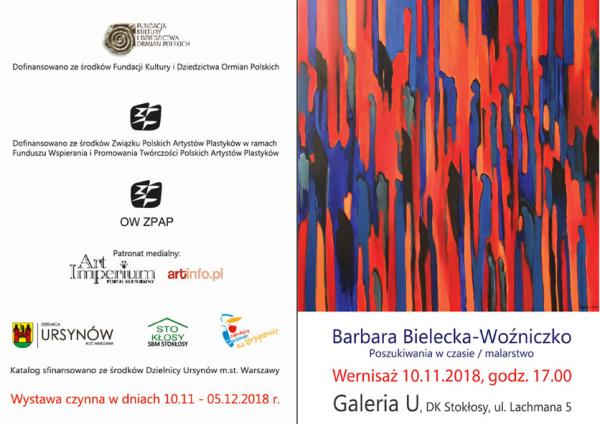 |
| Barbara Bielecka-Woźniczko obchodzi w tym roku podwójny jubileusz - 45-lecie pracy twórczej i okrągłą rocznicę urodzin. Z tej okazji zapraszamy na retrospektywną wystawę jej twórczości - „Poszukiwania w czasie”, na niej wybrane prace z różnych cyklów inspirowanych: muzyką, tańcem, przyrodą, kondycją ludzką, wydarzeniami historycznymi, wątkami ormiańskimi. Wernisaż już 10 listopada, o godz. 17:00, w Galerii U przy ul. Lachmana 5 w Warszawie. |
red.
|
|
29.10.2018. |
|
We were nominated for the award of Professor Aleksander Gieysztor
- below the quote from the text with justification
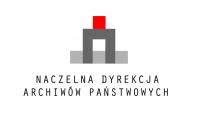 ...“In recognition of your work and activities Dr Wojciech Woźniak, Head Director of State Archives announced the Foundation of Culture and Heritage of Polish Armenians as the candidate for the award of Professor Aleksander Gieysztor. This award is granted for the special achievements in the activities directed at the protection of the Polish Cultural Heritage” ...“In recognition of your work and activities Dr Wojciech Woźniak, Head Director of State Archives announced the Foundation of Culture and Heritage of Polish Armenians as the candidate for the award of Professor Aleksander Gieysztor. This award is granted for the special achievements in the activities directed at the protection of the Polish Cultural Heritage”
All the information on the organized competition one may find at the website: "Fundacja Kronenberga". "Fundacja Kronenberga".
|
|
05.10.2018. |
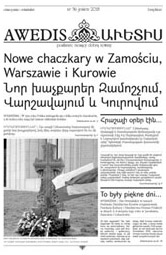 The 35th summer number of “Awedis” has just appeared. In the opening article of Editor in Chief we read as follows: The 35th summer number of “Awedis” has just appeared. In the opening article of Editor in Chief we read as follows:
Where Armenians are there are khachkars – we write about that in this very edition of Awedis. Armenia and the whole world of Armenian Diaspora would look different without those stone crosses. The stone cross is full of life ,flourishes like Armenian tradition and culture do in many countries ,in Poland too. Luckily the right to cultivate their specific culture and identity is one of the rights of ethnic minorities in modern democracies. But not always so that was. During PRL (Polish Peoples Republic) times in case of Armenians it was visible quite bluntly through the reluctance of authorities to the Armenian Catholic church. Remembering about this sad past we should appreciate the fact that nowadays there are no obstacles for organizing such events like Annual Armenian Days as well as the local authorities do not obstruct setting religious symbols (in the form of khachkars) in exhibited places of Polish cities.
In this number of “Awedis” we also are moving into the past. We publish a few interviews and reminiscence articles. Some of these concern distant times – from the beginning of XX century. The other ones refer to current issues like the political situation in Armenia in May this year and the peaceful revolution which led to the change of power in this country. We hope that these articles will be interesting for those to whom the complicated fate of Armenians in Poland and the world are particularly close.
|
|
29.08.2018. |
29.08.2018
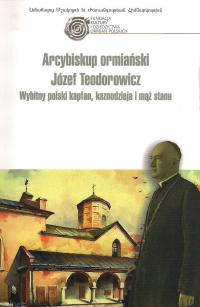 Ukazało się III wydanie wydawnictwa Abp ormiański Józef Teodorowicz. Wybitny polski kapłan, kaznodzieja i mąż stanu, bogato ilustrowana broszura, na którą składają się popularnonaukowe teksty poświęcone postaci Arcybiskupa, jego homiletyce oraz Kościołowi ormiańskiemu i dziejom polskich Ormian. Towarzyszy tej publikacji płyta CD z oryginalnymi nagraniami kazań głoszonych przez Arcybiskupa w 1938 r. oraz nagranie "Kazania sejmowego" w rekonstrukcji Macieja Rayzachera, wygłoszonego przez abpa Józefa Teodorowicza w 1919 roku. Wznowiona publikacja została udostępniona w związku z odsłanianiem tablicy poświęconej abp. Teodorowiczowi w katedrze warszawskiej, 9 lutego 2019 roku. Ukazało się III wydanie wydawnictwa Abp ormiański Józef Teodorowicz. Wybitny polski kapłan, kaznodzieja i mąż stanu, bogato ilustrowana broszura, na którą składają się popularnonaukowe teksty poświęcone postaci Arcybiskupa, jego homiletyce oraz Kościołowi ormiańskiemu i dziejom polskich Ormian. Towarzyszy tej publikacji płyta CD z oryginalnymi nagraniami kazań głoszonych przez Arcybiskupa w 1938 r. oraz nagranie "Kazania sejmowego" w rekonstrukcji Macieja Rayzachera, wygłoszonego przez abpa Józefa Teodorowicza w 1919 roku. Wznowiona publikacja została udostępniona w związku z odsłanianiem tablicy poświęconej abp. Teodorowiczowi w katedrze warszawskiej, 9 lutego 2019 roku.
Spis treści
• Jan Abgarowicz, Przedmowa do III wydania
• Kard. Kazimierz Nycz, Słowo wstępne
• Marek Jurek, Ormiański Skarga Drugiej Rzeczypospolitej
• Michał Zarychta, ks. Tadeusz Isakowicz-Zaleski, Życie i działalność
• Paweł Skibiński, Homiletyka Arcybiskupa
• Ks. Tadeusz Isakowicz-Zaleski, O Ormianach i Kościele ormiańskim w Polsce
• Stefan Kruczkowski, Aleksander Musiałowski, Unikatowe nagranie kazań Arcybiskupa na płytach bezpośredniego zapisu
• Armen Artwich, O Fundacji Kultury i Dziedzictwa Ormian Polskich
|
|
Read more
|
|
25.06.2018. |
 The 35th summer number of “Awedis” has just appeared. In the opening article Editor in Chief writes : The 35th summer number of “Awedis” has just appeared. In the opening article Editor in Chief writes :
Independence – how important is it? Being engaged in everyday life we can ignore how valuable is to have our own state. One should remember however that Poland as well as Armenia belonged to those countries which were deprived for many years of this state attribute. One hundred years ago the first Armenian state after middle ages was reborn and Poland after more than century regained its independence. The first Armenian Republic lasted for two years only being exposed to internal disorders and external wars. It was also struggling with the terrible consequences of the Armenian genocide taken place in the Ottoman Empire a short time ago. It was eventually invaded by the Soviet Army and incorporated together with the other parts of Caucasus into the Soviet Union for almost 70 years. Poland somewhat longer enjoyed its freedom namely up to the outbreak of the second world war but after the war it was forced to be in the zone of Soviet influences.
So called Autumn of Peoples (since 1989) has allowed Poland to become independent again from other countries. After difficult period of transformation Poland managed to join NATO and European Union and to become the example of proper development for other states of Middle and Eastern Europe. The fate of Armenia was much more difficult. The time of Communism tends to be remembered there as “golden years” contrary to “darkness and chill” years taking into consideration the earthquake in 1988, through Nagorno- Karabakh conflict until the half 1990s. It was in this period when many Armenians went to the West being without perspectives of work and normal life leaving the country with devastated industry, being destroyed by war and internal unrests like it was in 1918.
Nevertheless in the end of 20th century appeared in Armenia the new generation of people who were determined to cease the economic fall of the state, fight against corruption and oligarchic structures. Irrespective of the fact that in 2008 the authorities bloodily suppressed social protests this year people went out onto the streets again, demanding dismissal of the Prime Minister chosen by the Parliament and replacement of him by their own candidate. The protests ended with success and the authorities were changed. People were given hope for the better future, We believe that these changes will bring about the expected effects.
We invite you for reading. The 35th number of “Awedis” is available in internet too,www.awedis.ormianie.pl
|
|
13.06.2018. |
|
Serdecznie zapraszam do udziału w mszy św. ormiańskokatolickiej
w niedzielę, 17 czerwca 2018, o godzinie 11.00
w kaplicy Matki Bożej, przy ul. Łazienkowskiej 14, w Warszawie
Przed mszą św. będę udzielał chrztu w obrządku ormiańskim.
Po mszy św. – spotkanie z Jakubem Szyszko, który przez ostatnie pół roku przebywał na studiach
w Ammanie i opowie o Ormianach w Jordanii.
W czasie wakacji planowane są m.in. msze św:
4 sierpnia (sobota): msza św. ormiańskokatolicka w sanktuarium w Lubaczowie
z udziałem profesjonalnego chóru – podczas kilkudniowych ormiańskich obchodów
w ramach Festiwalu Dziedzictwa Kresów 2018.
15 sierpnia (środa – święto Wniebowzięcia NMP), w sanktuarium Matki Bożej Ormiańskiej
w Gdańsku, msza św. i błogosławieństwo winogron.
Wraz z serdeczną pamięcią i modlitwą
ks. Józef Naumowicz
duszpasterz Ormiańskokatolickiej Parafii Centralnej
pw. św. Grzegorza z Nareku
|
|
29.05.2018. |
|
Serdecznie zapraszam do udziału w mszy św. ormiańskokatolickiej
w niedzielę, 3 czerwca 2018, o godzinie 11.00w kaplicy Matki Bożej, przy ul. Łazienkowskiej 14, w Warszawie
W tę niedzielę, 3 czerwca, nasza msza św. w obrządku ormiańskim będzie miała niezwykły wymiar,
gdyż udział w niej zapowiedzieli klerycy I roku Wyższego Seminarium Duchownego w Warszawie
(koledzy naszych ormiańskich kleryków: Aharona, Arama i Nareka, razem ok. 25 kleryków)
i ich przełożeni z Seminarium w Urlach, posłuchamy też świadectwa naszych trzech ormiańskich kleryków
na temat ich rocznego już pobytu w Polsce i śpiewu kleryków I roku.
Po mszy św. – spotkanie przy kawie i herbacie.
Przed wrześniem w Warszawie będzie jeszcze jedna msza św. w obrządku ormiańskim
– 17 czerwca (trzecia niedziela miesiąca).
W czasie wakacji planowane są m.in. msze św:
4 sierpnia (sobota): msza św. ormiańskokatolicka w sanktuarium w Lubaczowie
– podczas kilkudniowych ormiańskich obchodów w ramach Festiwalu Dziedzictwa Kresów 2018.
15 sierpnia (środa – święto Wniebowzięcia NMP), w sanktuarium Matki Bożej Ormiańskiej
w Gdańsku, msza św. i błogosławieństwo winogron.
Wraz z serdeczną pamięcią i modlitwą
ks. Józef Naumowicz
duszpasterz Ormiańskokatolickiej Parafii Centralnej
pw. św. Grzegorza z Nareku
Informacje także na stronie Ordynariatu Kościoła Ormiańskokatolickiego w Polsce:
www.ordynariat.ormianie.pl
|
|
17.05.2018. |
|
Serdecznie zapraszam do udziału w mszy św. ormiańskokatolickiej
w niedzielę, 20 maja 2018, o godzinie 11.00
w kaplicy Matki Bożej, przy ul. Łazienkowskiej 14, w Warszawie
Po mszy św. odbędzie się spotkanie z panami
Zbyszkiem Manugiewiczem i Jerzym Tustanowskim,
autorami niedawno wydanej książki
„U podnóża Owidiusza. Rozkwit i zagłada wspólnoty kuckiej nad Czeremoszem”.
Po spotkaniu – czas na rozmowy z autorami i na potrawy ormiańskie.
Przed wakacjami w Warszawie będą jeszcze msze w obrządku ormiańskim 3 i 17 czerwca
(pierwsza i trzecia niedziela miesiąca)
Wraz z serdeczną pamięcią i modlitwą
ks. Józef Naumowicz
|
|
24.04.2018. |
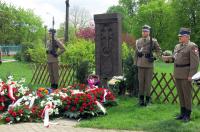
Today’s date 24th of April is symbolical for all Armenians. It recalls tragic events of year 1915. In the provinces administered by the Ottoman Empire 103 years ago the mass murder on the Armenian nation was committed. Recalling the memory of those events and more than 1,5 million victims Armenians and all their friends meet in order to commemorate this tragedy.
In Warsaw such a spot is “Skwer Ormiañski“ (Armenian square) whereby the memorial khachkar is placed. This year at this location gathered exceptionally many people. The chief organizer of the ceremony was the Ambassador of the Republic of Armenia in Poland His Excellency Edgar Ghazaryan. The ceremony at which numerous representatives of Polish authorities were present started with the minute of silence. After trumpet call ”Listen all” the Ambassador of Armenia in Poland took the floor welcoming gathered representatives of authorities, embassies, social organizations and numerous groups of Armenians. The representative of RP Senate read the special letter addressed to the Ambassador of the Republic of Armenia H.E. Edgar Ghazaryan from the marshal of senate Mr. Stanislaw Karczewski. Afterwards the laying down of flower wreaths took place by the representatives of Senate and Sejm. The wreath from the Ministry of Justice was laid down by the Minister Zbigniew Ziobro in person. There were also wreaths from the representatives of embassies, the representative of the Armenian minority in the Common Governmental and Ethnical minorities Commission, various Polish and Armenian organizations , foundations and associations acting in Poland.
The official part of the ceremony was ended with the common special prayer for the victims of genocide. Then present at the ceremony Armenians were laying flowers and burning candles.
|
|
|
19.04.2018. |
Letter from the General Director of the State Archives
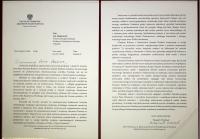
We decided to commemorate this year anniversary of the formation of our Foundation in a different manner than usual. This time we invited to the location of the Foundation representatives of the institutions which help us in carrying out our activities and support us financially. We arranged the exposition of the selected most interesting and most valuable exhibits from the collections of Polish Armenians archives. We had opportunity to show them to our guests taking into account the aspect of proper protection . We also told our guests about our accomplishments as well as projects were currently acting on.
It was especially relevant to us that the representatives of the institutions from which we received the means for carrying out our projects could personally have opportunity to assess the quality and effectiveness of using these means. We prepared special thanks to everybody concerned.
From the General Director of the State Archives through his deputy Dr Henryk Niestroj we received comprehensive thanks as well as congratulations as the acknowledgement of our activities so far. Present representatives of other institutions also expressed their appreciations for activities of our social archives which were considered to be exemplary model for others. Apart from the invited representatives of state offices at the meeting Prof. Krzysztof Stopka , Chairman of the Foundation Council was present. He presented some interesting facts from the history of Armenians . He highly appreciated the achievements of the Foundation in the past 12 years too. In the meeting Rev. Prof. Jozef Naumowicz “ Spiritual Foster Father” of our Armenian community took part as well.
We hereby quote the letter from the State Archives undersigned by the General Director Dr Wojciech Wozniak.
We also present some photographs from the meeting in the location of the Foundation of Culture and Heritage of Polish Armenians.
mot
Meeting devoted to the 12th anniversary of establishing the Foundation of Culture and Heritage of Polish Armenians in the location of Foundation.
|
|
|
15.04.2018. |
The 34th spring number of “Awedis” has just appeared. In the opening article Editor in Chief writes :
For a few latest years we have been commemorating centenaries of 20th century historical events. These are events connected mainly with the history of the 1st world war (1914-1918).
One of these events was the Armenian genocide in the Ottoman Empire started in 1915 the centenary of which we were commemorating three years ago. Such events which most probably would not have taken place if it were not for the 1st world war were as well formation of the 1st Republic of Armenia in May 1918 and regaining independence by Poland in November that year.
Armenian state declared its independence on the 28th of May what was possible among others thanks to victorious battles against Turks. (The most known was Sardarapat battle) If not for those winnings Turks would probably occupy the whole eastern part of Armenia and would not allow for revival of the Armenian statehood. Independent Armenia was in very difficult position due to the war destructions in all the fronts and first of all because of the necessity of taking care of thousands of refugees from the western Armenia, fugitives from Turks. Another enemy offensive ,this time Bolshevik one has not been repulsed and in the end of 1920 the young Republic ceased to exist.
The second Polish Rzeczpospolita (Republic) reborn again in 1918 existed longer time indeed but then it has become the victim of aggression from the neighbor states. Let us remember in this year in the centenary of Armenian and Polish statehoods being born again about the similarity of our states history and also about everything what connects us.
We invite you for reading. The 34th number of “Awedis” is available in internet too,www.awedis.ormianie.pl.
|
|
|
28.03.2018. |
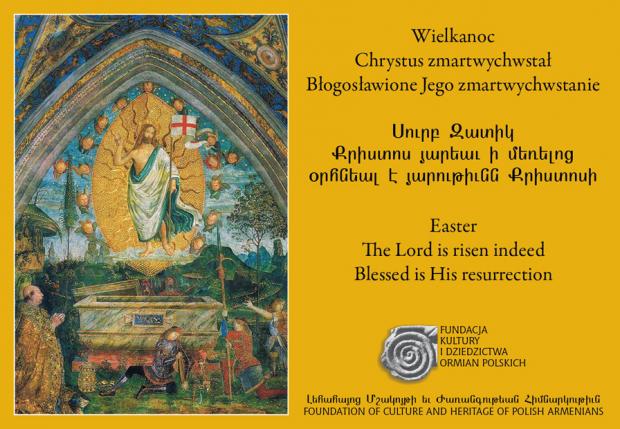
|
|
|
08.01.2018. |
Proboszcz Parafii Centralnej pod wezwaniem św. Grzegorza z Nareku
i Fundacja Kultury i Dziedzictwa Ormian Polskich
zapraszają
na poświęcenie repliki XVII-wiecznego ormiańskiego epitafium, którego dokona
ordynariusz wiernych obrządku ormiańskokatolickiego w Polsce
Jego Eminencja ks. Kazimierz Kardynał Nycz.
Poświęcenie epitafium poprzedzi ormiańskokatolicka msza św. celebrowana przez
ks. prof. Józefa Naumowicza
w niedzielę, 21 stycznia o godz. 14.00
w kościele oo. Dominikanów pw. św. Jacka, ul. Freta 10 w Warszawie.
|
|
|
31.12.2017. |
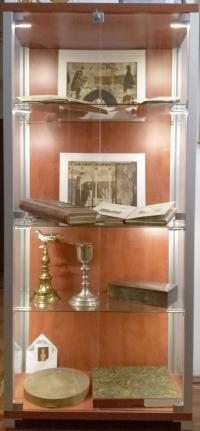
Najważniejszym celem prowadzonych przez Fundację Kultury i Dziedzictwa Ormian Polskich projektów jest jak najszersze udostępnienie wszystkim zainteresowanym historycznych informacji o polskich Ormianach oraz ich miejscu w kulturze i historii kraju.
Szczególne miejsce wśród projektów Fundacji zajmują te, które mają związek z archiwistyką i udostępnianiem zbiorów oraz opracowanych informacji przydatnych np. do badań genealogicznych.
Do poprzedniego numeru „Awedisu” dołączony został plan pod nazwą Ormiańskie Stare Powązki, dzięki któremu można się przekonać, jak licznie Ormianie i ich potomkowie uczestniczyli w życiu Warszawy od najdawniejszych czasów. Plan ten był także m.in. rozdawany przez harcerzy w okresie Zaduszek przy wejściach na cmentarz powązkowski. Plan powstał także w wersji online , gdzie dzięki wykorzystaniu nowych technologii można skorzystać z wirtualnej mapy cmentarza z dokładną lokalizacją grobów, obejrzeć fotografie, skorzystać z wyszukiwarki nazwisk, zapoznać się z życiorysami znanych postaci. Do wirtualnych Ormiańskich Starych Powązek można dotrzeć poprzez stronę www.archiwum.ormianie.pl w zakładce Cmentarze online . Dzięki intensywnym pracom nad identyfikacją warszawskich Ormian, na www.Wiki.Ormianie.pl powstały nowe biogramy wielu historycznych postaci zasłużonych dla rozwoju społecznego i gospodarczego stolicy.
Wirtualne Archiwum Polskich Ormian powiększyło się o nowe wyszukiwarki. Obok Ksiąg metrykalnych pojawiły się wyszukiwarki Duchowni oraz Pochowani na cmentarzach. W tej ostatniej zamieszczone już zostały dane wszystkich znanych nam Ormian i ich potomków pochowanych na Starych Powązkach w Warszawie (wraz z linkami wybranych postaci do ich biogramów w www.Wiki.Ormianie.pl) oraz dane z kilku pól (kwater) Cmentarza Łyczakowskiego we Lwowie; publikowanie danych z kolejnych pól będzie kontynuowane. W wyszukiwarce ksiąg metrykalnych pojawiły się nowe indeksy, a wśród nich dane z księgi małżeństw parafii ormiańskokatolickiej w Śniatynie, którą Fundacja skopiowała w poprzednim roku, z ksiąg zapowiedzi parafii w Horodence (1858–1890), Kut (1893–1953) oraz Tyśmienicy (1879–1922). Niemal wszystkim wpisom towarzyszą skany odpowiednich, oryginalnych fragmentów ksiąg. W wyszukiwarce Duchowni znajdują się informacje z 15 szematyzmów archidiecezji lwowskiej obrządku ormiańskiego. I te prace będą kontynuowane. Co ważne, w każdej wyszukiwarce jest aktualna informacja o tym, co już zostało zindeksowane, a co jeszcze jest do zindeksowania.
|
|
Read more
|
|
|
21.12.2017. |
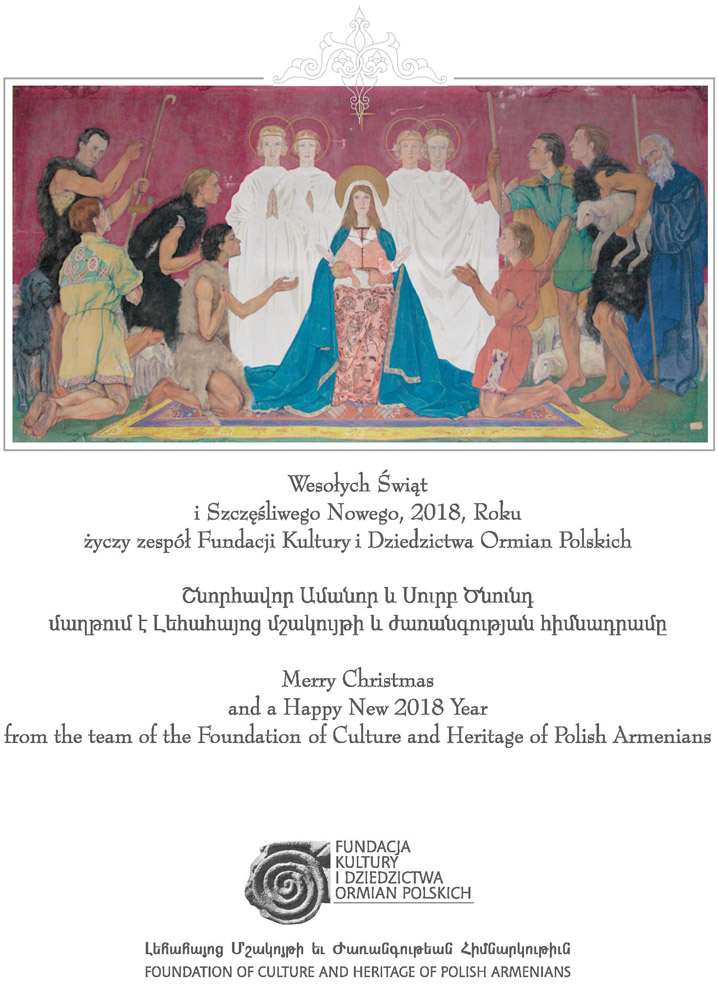
|
|
|
20.12.2017. |
|
The thirty-third, winter, issue of "Awedis" has been published. The editorial reads as follows:
There were not many such anniversaries in the history of Polish Armenians as this - 650 years of the Armenian diaspora in Poland. The Armenian events were exceptionally numerous, and about this anniversary, as well as about the 25th anniversary of the establishment of diplomatic relations between Poland and Armenia, all major media talked about and certainly all Armenians in Poland have heard. We wrote, write and we will be writing about these events.
Looking and participating in all these beautiful festivities that serve to popularize knowledge about Armenians all over Poland, we can also try to pause for a moment and wonder whether it is not worth asking: what does this anniversary mean for ourselves? Do we think about the heritage of Polish Armenians as our own, or do we feel that it escapes us and dies in the gloom of history? Do we feel good in our communities, or are they divided by divisions and disagreements? What will be the future of Armenians in this country?
You can answer these and other questions yourself. Meanwhile, the most important message of the anniversary will remain the awareness that Armenians in Poland have lived many centuries, and Poland is still a hospitable and attractive place for them, where they have a chance to find a better life. We hope that it will stay that way for a long time.
We invite you to read these articles. Thirty-third issue of "Awedisu" is also available on the website www.awedis.ormianie.pl .
|
|
|
03.11.2017. |
|
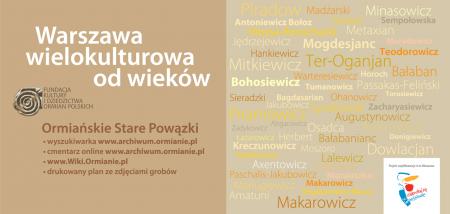
Fundacja Kultury i Dziedzictwa Ormian Polskich przygotowała plan Cmentarza Powązkowskiego w Warszawie z zaznaczeniem miejsc pochówków polskich Ormian oraz ich potomków i małżonków. Plan został opracowany w wersji papierowej i wersji wirtualnej na stronie Wirtualnego Archiwum Polskich Ormian www.archiwum.pl pod nazwą Cmentarze online -> Warszawa Stare Powązki.
Na stronie można m.in.:
- wyszukać nazwisko w wyszukiwarce (wyszukiwarka pokazuje także wyniki z innych cmentarzy, które dostępne są w serwisie Mogily.pl)
- zapoznać się ze spisem zmarłych Ormian i ich rodzin pochowanych na Starych Powązkach w Warszawie
- poznać dane biograficzne pochowanych
- obejrzeć fotografie nagrobków i pomników
- skorzystać z dokładnej mapy cmentarza – umożliwia on szczegółową lokalizację grobu wraz ze współrzędnymi GPS
- zapoznać się z życiorysami znanych Ormian i ich potomków.
- zapalić wirtualny znicz.
Plan powstał na podstawie inwentaryzacji cmentarnej, kwerendy archiwalnej oraz danych dostarczonych przez żyjących członków rodzin.
Przypominamy również, że na stronie Wirtualnego Archiwum Polskich Ormian jest wyszukiwarka nie tylko nazwisk, ale także inskrypcji.
Projekt wspólfinansowany ze środków Miasta Stołecznego Warszawy.
Hanna Kopczyńska-Kłos, Fundacja Kultury i Dziedzictwa Ormian Polskich
|
|
Read more
|
|
|
13.10.2017. |
|
The thirty-second, autumn, issue of "Awedis" has been published. The editorial reads as follows:
It's great when people organize themselves to achieve a common goal. And even better, when the goal turns into real. That's how it happened in Gdansk, when The Armenian Association (Związek Ormiański) opened its new premises in a beautiful tenement house in the oldest part of the city. The large number of guests who took part in the ceremony proved this initiative to be essential for Armenians in northern Poland. Certainly, every Armenian would like to have a place where he could meet other Armenians or people with similar interests. Now there is such a place in Gdańsk. The opening ceremony of the Armenian Association in Gdansk is part of outstanding array of great number of events, which were organized through this year on the occasion of the 650th anniversary of the presence of Armenians in Poland. There were conferences, unveiling plaques and monuments, concerts, Armenian days, Armenian evenings ... Not only in the main Polish cities.
In this issue of "Awedis" we covered several of these ceremonial events. We invite you to read the articles.
|
|
|
21.08.2017. |
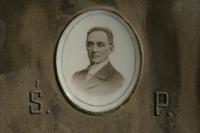
Fundacja Kultury i Dziedzictwa Ormian Polskich przygotowuje plan Cmentarza Powązkowskiego (Starych Powązek) w Warszawie, na którym zaznaczone zostaną miejsca pochówku osób ormiańskiego pochodzenia i fotografie ich grobów. Opublikowane też zostaną w www.Wiki.Ormianie.pl notki biograficzne o niektórych zmarłych. Plan cmentarza będzie dostępny online i będzie rozdawany przy różnych okazjach, w tym także na Powązkach około 1 listopada 2017 roku. Przygotowywana jest wyszukiwarka w www.archiwum.ormianie.pl.
Czy znają Państwo miejsca pochówku Ormian lub osób pochodzenia ormiańskiego na Starych Powązkach? Jeśli tak i gdyby zechcieli się Państwo podzielić tą wiedzą, to prosilibyśmy o:
- imię i nazwisko osoby pochowanej, lata życia
- pokrewieństwo z Państwem (o ile istnieje)
- kilka słów o osobie pochowanej (jeśli cokolwiek wiadomo)
- podanie lokalizacji grobu możliwie wg oznaczeń Cmentarza Powązkowskiego (kwatera - rząd - miejsce).
Informacje, które miałyby się znaleźć na planie Ormiańskich Starych Powązek zbieramy do końca sierpnia 2017 r., informacje nadesłane po tym terminie wykorzystamy online. Gdyby to było możliwe, to prosilibyśmy także o zrobienie zdjęcia grobu – ogólne i zbliżenie na tablicę/tablice i podanie autora tej fotografii.
Punktem wyjścia do planu Ormiańskich Starych Powązek jest plan dołączony do wydanego w 2012 roku albumu-książki „Ormiańska Warszawa”, gdzie zidentyfikowaliśmy 18 nagrobków i pomników osób ormiańskiego pochodzenia. Niezależnie od kierowanej do Państwa prośby, lokalizuję już takie miejsca pochówków na Starych Powązkach (na naszej liście jest już ponad 100 osób) i – o ile nie dostanę Państwa fotografii – opublikujemy własne.
Bardzo liczymy na Państwa wsparcie i prosimy o nadsyłanie wszystkich informacji, które pomogłyby nam zidentyfikować jak największą ilość osób ormiańskiego pochodzenia pochowanych na tym warszawskim cmentarzu.
Hanna Kopczyńska-Kłos, e-mail:
Ten adres email jest ukrywany przed spamerami, włącz obsługę JavaScript w przeglądarce, by go zobaczyć
Projekt dofinansowany jest przez Miasto Stołeczne Warszawa.
|
|
| «« start « previous 1 2 3 4 5 6 7 8 9 10 next » end »»
| | Results :: 21 - 40 of 189 |
|
 News
News  News
News